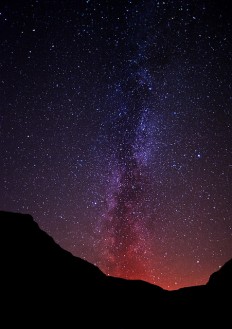To what extent am I an astronomer?
In The Shape of Time: Remarks on the History of Things, George Kubler* suggests that time is conveyed in signals, “kinetic energy stored until the moment of notice,” whose message is based on the past, like old light seen by astronomers. The signal energies, similar to karma, transmit impulses from the past, which form automatic circuits of experience. Like the ancient light of the stars, karma has been accumulating from time immemorial. The difference between the astronomer and myself is that the former is conscious that he is looking at old light, whereas I am not always aware of how my perception of the present is based on old habit energy.
the present moment is the moment free from habituation, when one is not imprisoned by karmic routine.
Kubler defines actuality as the time “when the lighthouse is dark between flashes.” The now is the rupture, gap, pause, or void when nothing is happening. In human experience, the present moment is the moment free from habituation, when one is not imprisoned by karmic routine. Even though in each moment everything changes, actuality “slips by too fast,” such that each instant admits but one action, leaving the rest of possibility unrealized.
Kubler compares man, unable to cope with invention or change, to a tightrope walker who is bound so fast to the cable that he cannot fall into the unknown.
Human knowledge of the world is based on our capacity for sensibility, which is limited by an invisible chain of prior events. As the means by which the universe is grasped, thought and language organize the “infinite continuation of non-identical events into a finite system of similitudes.” Perception depends on repetition. No event ever repeats, and yet, humans make sense of events by the identities imagined among them. The repetitive acts, which contain gradual, minute variations, are based on the fear of departing from the sanctity of routine. Kubler compares man, unable to cope with invention or change, to a tightrope walker who is bound so fast to the cable that he cannot fall into the unknown. Traffic stuck in a circuit at the gate of perception can be increased by increasing our willingness to discard incoming messages or by widening the gate so that more messages can enter.
To what extent am I, afraid of change, bound to the tightrope of habitual perception? With all of possibility at the door, why do I cling to what is familiar and forget to remain open to what could be? Every year we celebrate the “new” year, but what unplanned changes do we embrace in our lives? The year of the dragon marks a time of unpredictability and sudden change. Will I learn to fall willingly into the unknown or continue to strangle change with the tightrope patterns of habituation?
* One of the first historians of art in the United States, Kubler focused on art from the Americas during his career at Yale University. He wrote The Shape of Time: Remarks on the History of Things (New Haven: Yale University Press, 1962) to describe how duration can be studied through the history of material things. His discussion of the artist, whose inventions are limited by signal energy, reminded me of the human condition of being bound to karma.

